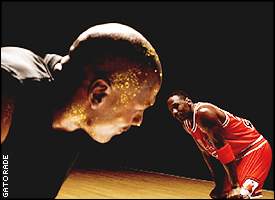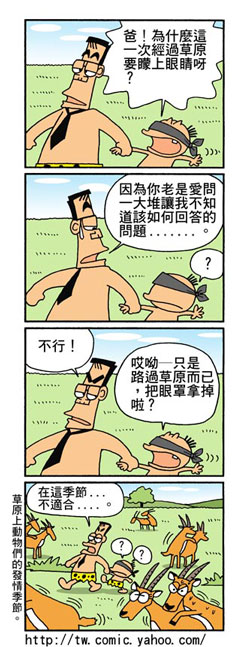Topic: Review
Now I'm not a sports fan, not by a long, long shot. Maybe it's the intensity of the competition, the purity of the skill, the romance of a perfect glorious moment, that makes sports moments so emotional and cathartic. Sometimes sports moments engender the best advertising campaigns. This one is from Gatorade: "23 vs. 39".
MJ's ready for his close-up
By Eric Neel, ESPN Page 2 Columnist
>>excerpts only - for full article click on link provided<<
Michael Jordan is working out in a gym alone, just shooting around. A door opens on the other side of the building, and in walks none other than Michael Jordan.
Only this is the young-legs MJ, the circa-'87 MJ, complete with a No. 23 Bulls uni, a pair of the old, bold red-and-black Airs on his feet, and hops for days and days and days. The game is on.
 Experience versus hunger. Wisdom and guile head-to-head with brilliant abandon. Head-fakes and shoulder leans on the perimeter against head-fakes and acrobatics around the rim. Trash talk in both directions. Playoff intensity and playground swagger in the air.
Experience versus hunger. Wisdom and guile head-to-head with brilliant abandon. Head-fakes and shoulder leans on the perimeter against head-fakes and acrobatics around the rim. Trash talk in both directions. Playoff intensity and playground swagger in the air.As for why the ad works? This stuff is subjective, of course, but I'll offer up a short list of why I think it strikes a chord:
1. It's bitchin' -- Camaro bitchin', cherry, sweet, clean, cool and fly. Do people still say "tight"? If they do -- even if they don't -- I'll say it: This ad is tight. You don't analyze this kind of thing too closely, you just know it when you feel it and you're glad of it. It's the kind of thing you know by its symptoms: a slow, sloppy head-wag and chuckle, a little spike in the heart rate, some shallow breathing, an urge to grab somebody and make them watch and wait with you for the next time it comes on -- this kind of thing.
2. The young Jordan, the one who dunked everything he got his hands on, from any spot on the floor, the one who seemed to tear through defenses like the Alien screaming through Ripley's ship, is somebody any of us who've watched the game in the last 15 years still carry around in our heads -- some with delight and some with fear. And either way, there's a wild kind of rush in seeing him again, not in some clip we know from before, but in a new context, against a new foe.
3. No soundtrack, just voices and crashing game sounds -- like that, that's nice.
4. The intricate marriage of technology and biology that went into making the ad are actually almost invisible in the end. The extraordinary technique ends up making things seem ordinary. What I mean is, the impossibility of the scenario gets squeezed out by the believability of the images of MJ-young and MJ-old, staring each other down. And what you have left feels like a familiar, genuine showdown, the kind of thing that could be played out in a gym, in a driveway, on a Nerf hoop in somebody's den, anywhere.
There's only one person that can wear down MJ.
5. The yesterday-vs.-today fantasy matchup stuff is deep in the vein of the way sports fans think all the time. The elders-teaching-the-youngsters, youngsters-bucking-the-elders thing is even older and deeper than that.
6. There's a bit of farewell in the spot. We know we're seeing something close to the end of the MJ-era now, and by calling up the young man in Chicago, and the very young man in Chapel Hill, it gives us a chance to think of the scope of that era, to appreciate and reminisce.
7. The present-day MJ isn't surprised to see his younger self stroll onto the floor. It's like he's always known he was lurking, like he's been thinking about him, playing against him in his mind, using himself to push himself. There's an intriguing little peek inside one of the more guarded personalities of our generation in this, I think.
8. The powder-blue-and-white punch line is just right.
9. Every one of us can imagine (probably has imagined) being where MJ is in this moment. Were we more powerful back then, when our reflexes were quicker, when we could jump and reach a little (maybe a lot) higher than we can now? Or is experience the thing? Can we think our way into and out of possibilities and scrapes now that we would only have stumbled through then? And is that the power?
And the beauty of the ad is that it doesn't resolve the question. Both young and old Michael have their moments. The game is fierce, but it's never decided. "Michael said he couldn't let either his young self or his present-day self win," Ryan told me. "Because that would mean one of him would lose." It's a sweet stroke on MJ's part: We're left to wonder, but also to trust in and appreciate both versions -- young and old -- of him, and maybe even on some level, of ourselves.
10. Um, he's Michael Jordan.

 And while we're on this tip, because "Rumble, young girl, rumble" -- in addition to being a touching homage and a clever flip of the script -- is a line you hope every daughter you have and every little girl you know commits to memory and whispers like a mantra before every single game, test, and trial of her life.
And while we're on this tip, because "Rumble, young girl, rumble" -- in addition to being a touching homage and a clever flip of the script -- is a line you hope every daughter you have and every little girl you know commits to memory and whispers like a mantra before every single game, test, and trial of her life.

